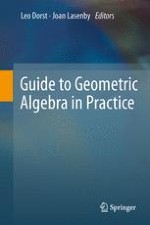2011 | OriginalPaper | Buchkapitel
11. On the Use of Conformal Geometric Algebra in Geometric Constraint Solving
verfasst von : Philippe Serré, Nabil Anwer, JianXin Yang
Erschienen in: Guide to Geometric Algebra in Practice
Verlag: Springer London
Aktivieren Sie unsere intelligente Suche, um passende Fachinhalte oder Patente zu finden.
Wählen Sie Textabschnitte aus um mit Künstlicher Intelligenz passenden Patente zu finden. powered by
Markieren Sie Textabschnitte, um KI-gestützt weitere passende Inhalte zu finden. powered by
